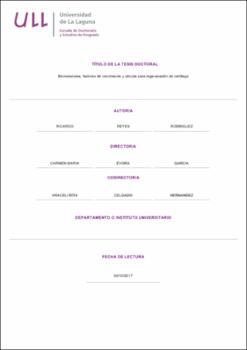Biomateriales, factores de crecimiento y células para regeneración de cartílago
Autor
Reyes Rodríguez, Ricardo
Fecha
2017Resumen
El cartílago articular constituye una variedad de tejido conjuntivo que recubre los extremos de las articulaciones sinoviales proveyendo una superficie de baja fricción y distribuyendo la carga al hueso subcondral subyacente. El cartílago se caracteriza por su baja densidad celular y por la ausencia de vascularización e invervación, lo que hace muy difícil su autoreparación tras una lesión. El escaso éxito de los tratamientos convencionales aplicados hasta el momento, ha potenciado en los últimos años el desarrollo de la ingeniería de tejidos para la reparación de lesiones del cartílago. En este trabajo, se elaboran y ensayan dos sistemas biocompatibles, evaluando su capacidad condrogénica en la reparación de un defecto osteocondral crítico en fémur de conejo. El primer sistema, un scaffold de doble capa de alginato-PLGA (ALG-PLGA), conteniendo BMP-2 (2.5 y 5µg) o TGF-ß1 (50 ng) (FC) encapsulados en microesferas de PLGA, controló de manera eficaz la liberación de los FC, y mostró una alta tasa de reparación a las 12 semanas postimplantación, en todos los grupos tratados con FC. El segundo sistema, también de doble capa, incorporó un nuevo poliuretano segmentado (SPU) en sustitución del alginato, y mostró igualmente excelentes resultados en el control de la liberación de los FC, y en la reparación del defecto a las 12 semanas postimplantación, en todos los grupos tratados con FC. En función de varios aspectos, entre ellos la velocidad de degradación de los sistemas, se seleccionó el sistema de ALG-PLGA como el más idóneo, y la BMP-2 a dosis de 5µg como la más adecuada, para evaluar, de forma comparativa, la capacidad condrogénica del tratamiento con células madre mesenquimales derivadas de la médula ósea (MSC) o condrocitos autólogos (rbC), solas, o en combinación con BMP-2. La eficacia reparadora de todos los tratamientos individuales o en combinación fue la misma a las 12 semanas postimplantación. El análisis global de los resultados muestra por una parte, que ambos sistemas son adecuados para su aplicación en ingeniería de tejidos, y por otra, justifica el uso de FC (BMP-2/TGF-ß1) frente a la terapia celular en medicina regenerativa del cartílago. Joint cartilage forms a variety of connective tissue that lines the ends of synovial joints providing a surface of low friction and distributing the load to the underlying subchondral bone. Cartilage is characterized by low cell density and absence of vascularization and inervation, which makes it very difficult to repair after injury. The lack of success of the conventional treatments applied so far has boosted in recent years the development of tissue engineering for the repair of cartilage lesions. In this work, two biocompatible systems are elaborated and tested, evaluating their chondrogenic capacity in the repair of a critical osteochondral defect in rabbit femur. The first system, a bilayered scaffold of alginate-PLGA (ALG-PLGA), containing BMP-2 (2.5 and 5 ¿g) or TGF-ß1 (50 ng) (FC) encapsulated in PLGA microspheres, controlled the release of GF, and showed a high rate of repair 12 weeks post-implantation, in all groups treated with GF. The second, bilayered system, incorporated a new segmented polyurethane (SPU) to replace the alginate, and also showed excellent control of the release of GF, and a high repair rate of the defect 12 weeks post-implantation, in all groups treated with GF. Based on several aspects, including the degradation rate of the systems, the ALG-PLGA system was selected as the most suitable, and BMP-2 at a dose of 5¿g as the most appropriate, to evaluate, in a comparative way, the chondrogenic capacity of treatment with bone marrow-derived mesenchymal stem cells (MSC) or autologous chondrocytes (rbC), alone, or in combination with BMP-2. The repair efficacy of all individual treatments or in combination was the same 12 weeks postimplantation.The global analysis of the results shows, on the one hand, that both systems are suitable for application in tissue engineering, and on the other hand, it justifies the use of GF (BMP-2 / TGF-ß1) against cell therapy in regenerative medicine of cartilage.





